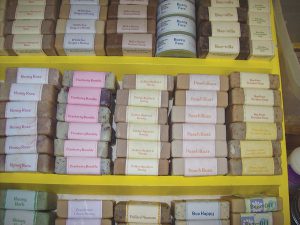Do Some of These This Year
By: Ann Harman
It’s January! A New Year! Hang up your brand new Bee Culture 2015 bee calendar! You spent New Year’s Eve making some New Year’s Resolutions. Their normal lifetime is usually a few weeks. However, today it is time to make some New Year’s Beekeeping Resolutions. Now these you need to keep throughout the year if you are gong to be a Better Beekeeper in 2015.
So let’s start: I resolve to –
Read the Christmas present beekeeping book. Well, you asked Santa for it because it would give you the latest information and is well-illustrated. If you read it during the dull days of Winter you can be ready for building your colonies up to honey production level without swarming. One problem with all beekeeping books is that the information presented does not quite fit every part of the country. Beekeepers in the warm areas of the South will start bee work much sooner than those in Minnesota. But you can easily adapt your new information to your part of the country. Pay attention to the section on successful requeening so you can try out some new techniques this coming year.
Perhaps the book you wanted and received is about plants so that you could help not only your bees but also other pollinators. Remember that the relatively few plants in your garden will not make a honey crop but they will provide an assortment of nectar and pollen for a bee’s balanced diet. Go ahead and show your neighbors your plant book and explain that these plants provide good nutrition for healthy pollinators.
Be a mentor to a beginning beekeeper. To teach is to learn. You will not be doing the newbee’s bee work but acting as a guide and answering questions. Looking into a beehive is always educational (why did this colony put drone cells there?) and fun (just look at that perfect brood pattern!). Newbees need reassurance that all is well. They also need support if the queen dies. If you can quickly provide a queen or a frame with eggs and young larvae you will have saved a colony and prevented the newbee’s disappointment. Your local beekeepers club will be pleased that you became a mentor.
Have a plan for opening a hive. You have your veil on, hive tool in hand and are lighting your smoker. Stop. Ask yourself: Why am I going into this hive? Think. Am I looking for disease, food, brood? Or am I ‘just looking?’ Bees function best when not disturbed. Even if you are careful in pulling out a frame you may have scraped open some honey-filled cells. Housekeeper bees will have to clean up and repair comb even if the damage is small. Cool air may be entering the hive and house bees must hasten to protect brood. If you have small hive beetle infestation, any disturbance may encourage the female beetle to lay more eggs, thus increasing the population. With a good plan in mind, then open and disturb as little as necessary. If a problem were found then that would be a perfectly good reason to return for observation or correction.

Keep some sort of records.
Keep some sort of records. Yes, you can use the ‘brick method’ of indicating ‘all is well,’ or ‘bad queen.’ But we are all perfectly capable of forgetting which hive has a two-year-old queen or if ‘that hive’ has a bad inner cover or is it that hive over there? Although the hive inspections result in sticky fingers or gloves, our phones and pads make handy record keepers. Either protect them from sticky honey and even stickier propolis or protect your fingers with exam gloves that can be removed easily. We can enter brief comments – ‘feed #4’ or ‘make nuc #6.’ Add the date of your notes and now you can do something with those hives without disturbing any others. Keeping records of queens can help you decide which are worth keeping and which need requeening now or before Winter. Keep records but don’t make them so complicated that you won’t use them.
Be a Weather Watcher. Endless drought in California and endless rain with flooding in another part of the U.S. are all reported on radio and TV. Bees have had to cope with weather as long as they have been on earth. And they managed as best they could. Today we are stewards of our bees and thus have the responsibility to make sure they have good living conditions and sufficient food. Our weather patterns are definitely changing. Our apiary sites may become more prone to flooding, especially flash floods that suddenly sweep away not only cars but also beehives. Apiary sites are limited, even in rural areas so escaping floods may not always be possible.
However drought is something we need to notice. Weeks, even months without rain affect our bee pasture. So have you noticed that your colonies are short of food? We may think about our vegetable garden and water the wilting plants. However, checking all colonies for food supplies is just as important. It is simply easier to see a wilting tomato plant than a hungry colony. During severe drought you may get a reduced honey crop or none at all but you do need to keep your colonies alive until weather conditions improve.
Be a Plant Watcher. Yes, plants can be good indicators of weather conditions. Too much rain can cause some plants to have excessive growth but little flowering. The nectar in those flowers can be more dilute or even washed out. In drought conditions have you noticed that wild plants are not growing as well? You don’t even have to search out bee plants. Just observe any flowering plant, not artificially watered. Is it smaller than usual? Fewer flowers? Smaller flowers? The plant can only grow and produce flowers with good growing conditions. Let plants reinforce your weather observations.
Other plant information can enter into your beekeeping. Can you really keep track of what is going on in those 18,000 acres around your beeyard? You can’t see over that hill; you never go down that road. Farmland that was supporting bee pasture for years is now a housing development or is growing wheat. Your bees lost a food supply. It may be difficult but try to keep track of your surroundings.
Another good reason to be a Plant Watcher (and a Weather Watcher, too) is the approach of blooming of your honey crop plants. You have your honey supers ready but when to put them on? The plants will let you know.
Control those pests, Varroa and small hive beetle. This would be a good time to review just how well your controls of varroa and small hive beetle have been working. Perhaps it is time to review what is available from the equipment suppliers for both of these pests. Now is the time new products come on the market that may be more effective or easier to use. Here is where you can think back – and review your records (if you kept any). If you had happy, healthy colonies perhaps you do not need to make a change. However, if you notice something new in the catalogs, go ahead and try it on a colony or two. Then, provided you are keeping records (see above), you can decide to make a change or not.

Learn something new.
Try making something new. You have been making beautiful candles that sell very well. However have you ever made lip balm or lotion bars? What about making mead or honey beer? Look at the books and equipment available in the equipment suppliers’ catalogs for doing any of those. It’s Winter now so you are not very busy with bees. It’s a good time to get out of a rut.
Learn about other pollinators and other stinging insects. We know our honey bees are in trouble, but so are bumble bees and the numerous ‘pollen bees.’ You have probably had questions about carpenter bees and been called about capturing ‘those bees’ that turned out to be yellowjackets. Even if you live outside the range of Africanized bees you probably have been asked about ‘Killer Bees.’
We think about the environmental problems our honey bees have but those problems also affect other pollinators and predators, such as wasps and yellowjackets. As beekeepers we need to give good information about them when asked questions. Can you give the same useful information about bumble bees –their yearly life style, different sizes (species), and why they need to be protected?
This Winter is a good time to become knowledgeable about all these critters and their value. Much information can be found on the Internet and in some books. A fairly new, small, inexpensive publication, Wasp and Bee Management, by Jody Gangloff-Kaufmann, has concise information about various bees and wasps. It can be ordered from PALSpublishing@cornell.edu.
Participate in local and state association activities. These associations bring speakers to provide beekeepers with new ideas and new research results. At large meetings equipment suppliers will be happy to bring you pre-ordered supplies to save you freight costs. Meetings are a good place to share beekeeping information – what worked and what didn’t.
If you have been attending these meetings are you one of those who arrive at the last minute and leave immediately when the Chair said ‘meeting adjourned?’ Perhaps you could help in some way, either before, or during or after the meetings. Help could be as simple as putting away a few chairs or tables, arranging door prizes or bringing some refreshments. Associations, large or small, are always better with more participation.
Bee Prepared. Get organized! Mend, repair and paint equipment before it is needed. Buy supplies before they are needed. Have honey supers ready before the blossoms burst. Rotate out old comb. Keep apiary clean. Make sure bear fence is working before the bears wake up. Plan management strategy before the bee season starts.
Read something in every issue of Bee Culture. If your excuse is ‘don’t have time’ then read the list of articles and authors to pick out the ones that seem most important at the moment. Don’t forget the editorials and Book Reviews (you might find an idea for a birthday present), Look at the advertisements – you might see something you forgot to order. If the football game is more important, read during the time outs and commercials. Be informed to be a Better Beekeeper!
Ann Harman makes and keeps her New Year’s Resolutions at her home in Flint Hill, Virginia.






